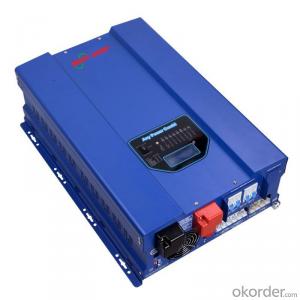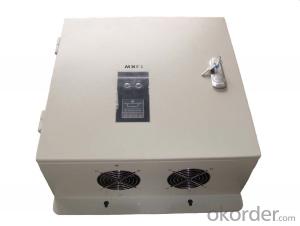Kstar Solar Inverter - Single Phase Inverter Made in China
- Loading Port:
- Shanghai
- Payment Terms:
- TT OR LC
- Min Order Qty:
- 0 watt
- Supply Capability:
- 10000 watt/month
OKorder Service Pledge
OKorder Financial Service
You Might Also Like
Description of Single Phase Inverter
Solar ac power system consists of solar panels, charge controllers, inverter and battery; Solar energy does not include inverter dc power system. Inverter is a kind of power conversion device, inverter by incentives can be divided into self-excited oscillation inverter and separately excited oscillation inverter.
Features of Single Phase Inverter
High MPPT accuracy(>99.9%)
Wide DC input range (60~300 Vdc), compatible with different module
Easy to wire, install and operate
IP65 design, suitable for indoor and outdoor installation
10 years warranty(5~25 years optional)
New high frequency design Higher power quality
Casting shell design Beautiful and convenient installation
Technical Data of Single Phase Inverter
| Type | Omniksol-1k-TL2-M |
| Input(DC) | |
| Max.PV Power | 1.25kW |
| Max,DC Voltage | 500V |
| Operating MPPT Voltage Range | 60-450V |
| MPPT Voltage Range at Nominal Power | 100-300V |
| Start up DC Voltage | 70V |
| Turn off DC Voltage | 50V |
| Max, DC Current | 11A |
| Max, Short Cicuit Current for each MPPT | 14A |
| Number of MPP trackers | 1 |
| Number of DC Connection for each MPPT | 1 |
| DC Connection Type | MC4 connector |
| Output(AC) | |
| Max,AC Apparent Power | 1000VA |
| Nominal AC Power (cos phi = 1) | 1000W |
| Nominal Grid Voltage | 220V/230V/240V |
| Nominal Grid Frequency | 50Hz/60Hz |
| Max, AC Current | 5.0A |
| Grid Voltage Range** | 185-276V |
| Grid Frequency Range** | 45-55Hz/55-65Hz |
| Power Factor | >0.99 |
| Total Harmonic Distortion(THD) | <3% |
| Feed in Starting Power | 30W |
| Night time Power Consumption | <1W |
| Standby Consumption | 6W |
| AC Connection Type | Plug-in connertor |
| Efficiency | |
| Max,Efficiency | 96.5% |
| Euro Efficiency | 95.8% |
| MPPT Efficiency | 99.9% |
| Safety and Protection | |
| DC Insulation Monitoring | Yes |
| DC Switch | Optional |
| Residual Current Monitoring Unit (RCMU) | Integrated |
| Grid Monitoring with Anti-islanding | Yes |
| Protection Class | Ⅰ(According to IEC 62103) |
| Overvoltage Category | PV Ⅱ/ Mains Ⅲ(According to IEC 62109-1) |
| Reference Standard | |
| Safety Standard | EN 62109, AS/NZS 3100 |
| EMC Standard | EN 6100-6-1, EN 6100-6-2, EN 6100-6-3 EN 6100-6-4, EN 6100-3-2, EN 6100-3-3 |
| Grid Standard | VDE-AR-N4105. VDE-0126-1-1,G83/1,EN 50438,RD1699,CEI 0-21, AS4777,C10/C11 |
| Physical Structure | |
| Dimensions | 210x290x90mm |
| Weight | 5kg |
| Environmental Protection Rating | IP 65 (According to IEC 60529) |
| Cooling Concept | Natural convection |
| Mounting Information | Wall bracket |
| General Data | |
| Operating Temperature Range | -25℃ to +60℃(derating above 45℃) |
| Relative Humidity | 0% to 98%, no condensation |
| Max. Altitude (above sea level) | 2000m |
| Noise Type | <45dB |
| Isolation Type | Transformerless |
| Display | 2LED Backlight 16*2 Character LCD |
| Data Communication | RS485(WiFi, GRPS optional) |
| Computer Communication | RS232 as option |
| Standard Warranty | 10 Years (5-25 years optional) |
IMages of Single Phase Inverter



FAQ
Q: Do you have the CE, TUV, UL Certification?
A: We’ve already passed all the tests, and any certificate is available.
Q: Have you ever sold your products to companies in my country?
A: Of course, we have customers in all general PV markets, but I think we should expand our market share along with the market growth.
Q: When did your company set up? You are a new company, how can I believe your quality?
A: We entered into Solar PV industry in 2005, now we have several plants in manufacturing of a-Si and c-Si panels, and our capacity is 220MW per year. Till now we have already passed all the tests by authorized laboratories, e.g. TUV, CE, UL.
Q: Can you help us install the module if we cooperate with you?
A: We haven’t entered into installation sector, but we have the plan in near future.
Q: How do you pack your products?
A: We have rich experience on how to pack the panels to make sure the safety on shipment when it arrives at the destination.
Q: Can you do OEM for us?
A: Yes, we can.
Q: Can we visit your factory?
A: Surely, I will arrange the trip basing on your business schedule.
- Q: What is the maximum temperature range for a solar inverter?
- The maximum temperature range for a solar inverter typically varies between -25°C to 60°C (-13°F to 140°F), although it can vary depending on the specific model and manufacturer.
- Q: Can a solar inverter be used with solar-powered water pumps?
- Yes, a solar inverter can be used with solar-powered water pumps. A solar inverter converts the DC power generated by solar panels into AC power, which is suitable for running various electrical devices, including water pumps. This allows the solar panels to directly power the water pump, enabling it to operate efficiently using renewable energy from the sun.
- Q: What is the role of a synchronization circuit in a solar inverter?
- The role of a synchronization circuit in a solar inverter is to ensure that the inverter is synchronized with the utility grid. This circuit monitors the frequency and phase of the grid and adjusts the inverter's output accordingly to match the grid's characteristics. By synchronizing the inverter with the grid, it allows for safe and efficient power transfer, prevents disruptions to the grid, and enables the inverter to operate in parallel with other power sources.
- Q: Can a solar inverter be used in a solar-powered street lighting system?
- Yes, a solar inverter can be used in a solar-powered street lighting system. A solar inverter is responsible for converting the direct current (DC) produced by solar panels into alternating current (AC) that can be used to power the street lights. Therefore, it plays a vital role in ensuring that solar energy is efficiently utilized in the lighting system.
- Q: Can a solar inverter be used with both AC and DC power sources?
- No, a solar inverter is designed to convert DC power generated by solar panels into usable AC power for household or grid consumption. It cannot be used directly with DC power sources.
- Q: Can a solar inverter be used with a solar-powered CCTV system?
- Yes, a solar inverter can be used with a solar-powered CCTV system. A solar inverter is responsible for converting the direct current (DC) produced by solar panels into alternating current (AC) that can be used to power electrical devices. In the case of a solar-powered CCTV system, the solar inverter can convert the DC power generated by the solar panels into the AC power required to run the CCTV system, ensuring it functions properly.
- Q: How does a solar inverter handle variations in grid voltage?
- A solar inverter handles variations in grid voltage by continuously monitoring the grid voltage and adjusting its own output voltage accordingly. It uses advanced control algorithms to maintain a stable and consistent output voltage despite fluctuations in the grid voltage. This ensures that the solar power generated is synchronized with the grid and can be seamlessly fed into the electrical system.
- Q: Can a solar inverter be used in a mobile or portable solar power system?
- Yes, a solar inverter can be used in a mobile or portable solar power system. A solar inverter is responsible for converting the direct current (DC) generated by the solar panels into alternating current (AC) that can be used to power various devices. By incorporating a solar inverter into a mobile or portable solar power system, it becomes possible to harness solar energy and use it to power electronic devices while on the go. This makes it a convenient and sustainable option for providing electricity in remote locations or during outdoor activities.
- Q: What is the role of a solar inverter in preventing electrical hazards?
- The role of a solar inverter in preventing electrical hazards is to convert the direct current (DC) power generated by solar panels into alternating current (AC) power that can be used in homes and businesses. By regulating the voltage and frequency of the electricity, the inverter ensures that the power is safe and compatible with the electrical grid. Additionally, solar inverters have built-in safety features such as ground fault protection and rapid shutdown mechanisms, which help prevent electrical hazards such as fires, shocks, and damage to the system.
- Q: Solar grid inverter does not merge into the grid, direct access to the load to the load power supply?
- Inverter is the DC power (battery, battery) into alternating current (usually 220V, 50Hz sine wave). It consists of inverter bridge, control logic and filter circuit
Send your message to us
Kstar Solar Inverter - Single Phase Inverter Made in China
- Loading Port:
- Shanghai
- Payment Terms:
- TT OR LC
- Min Order Qty:
- 0 watt
- Supply Capability:
- 10000 watt/month
OKorder Service Pledge
OKorder Financial Service
Similar products
Hot products
Hot Searches
Related keywords




























